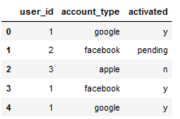
Reputation: 541
Making a pivot table across multiple columns of non-numeric data
The following code generates a dummy dataframe:
import pandas as pd
df = pd.DataFrame(
{
'user_id': [1,2,3,1,1],
'account_type': ['google','facebook','apple','facebook','google'],
'activated': ['y','pending','n','y','y']
}
)
df.head()

What I need is to create a pivot table for unique_values in the account_type column, which aggregates by the user_id column.
Essentially, for each user_id, I want to see how many of each types of accounts have a value other than n under the activated column.
The resulting dataframe should be:
I'm beat by this so far because I the pivot_table function seems to only be able to work with numeric values.
Upvotes: 0
Views: 202
Answers (2)

Reputation: 862611
Use DataFrame.assign for new column filled by mask compared activated for no n, and then pivoting by DataFrame.pivot_table with aggfunc=sum for count Trues:
df = (df.assign(new= df['activated'].ne('n'))
.pivot_table(index='user_id',
columns='account_type',
values='new',
fill_value=0,
aggfunc='sum')
.rename_axis(columns=None))
print (df)
apple facebook google
user_id
1 0 1 2
2 0 1 0
3 0 0 0
Upvotes: 1

Reputation: 24314
Try Via groupby(), where() and transform() method:
df['count']=(df.groupby(['user_id','account_type'])['activated']
.transform(lambda x:x.where(df['activated'].ne('n')).count()))
Finally use pivot_table() and rename_axis() method:
result=df.pivot_table(index='user_id',columns='account_type',values='count',fill_value=0).rename_axis(columns=None)
Output of result:
apple facebook google
user_id
1 0 1 2
2 0 1 0
3 0 0 0
Upvotes: 2
Related Questions
- Pivoting a Pandas Dataframe containing strings - 'No numeric types to aggregate' error
- Pivot table for non numerical data frame pandas
- How to groupby and pivot a dataframe with non-numeric values
- pivot_table() to a df no numeric types to aggregate
- Pandas - Pivot table based on non-numerical data
- Pivoting a Pandas Dataframe, no numeric types, index is not unique
- Pandas: pivot dataframe and preserve additional non-numeric column
- Combining categorical data with numeric data when using pivot_table
- pandas - pivot_table with non-numeric values? (DataError: No numeric types to aggregate)
- Pivot Pandas Dataframe with a Mix of Numeric and Text Fields
